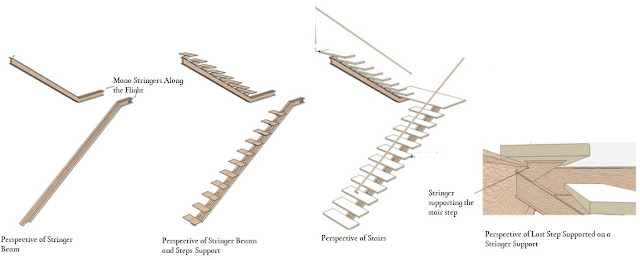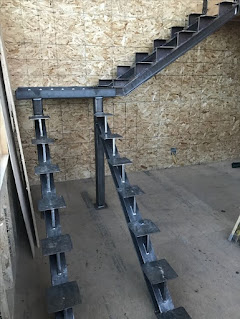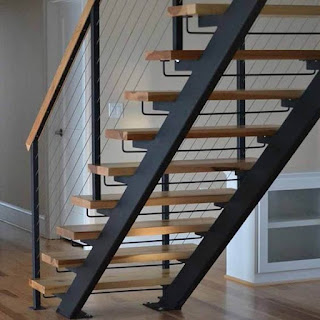Search This Blog
Most Popular
Categories
- Building Construction (87)
- Building Materials (85)
- Columns (2)
- Concrete Beam (3)
- Concrete Construction Techniques (6)
- Concrete Mix Design (15)
- Concrete Repair (14)
- Concrete Slab (11)
- Construction Equipment (17)
- Construction News (7)
- Design of Structures (19)
- Engineering Drawing (1)
- Estimation (3)
- Geotechnical engineering (26)
- Highway Engineering (11)
- Innovations (34)
- Material Testing (11)
- Matrix Analysis of Structures (2)
- Mechanical Engineering (3)
- Strength of Materials (2)
- Structural Analysis (13)
- Structural Design (24)
- Structures (17)
- Transportation Engineering (9)
What are Floating Stairs?
Team Prodyogi
August 19, 2022
Floating stairs are a type of open-rise stairs that are supported by a single stringer or a recessed stringer in the center or the side of the staircase. This unique staircase design gives the visual effect of the stair thread being "floating" in space.
3. Types of Floating Stairs: Different types or styles of the staircase are classified based on: 1) The position and type of stringer and 2). The directional run of the staircase. Based on the position of the stringer, it can be a mono, double, or cantilever floating stair. Based on the directional run of the stair, it can be straight, L-shaped, curved, spiral, or winder shaped.
Floating stairs are a type of modern staircase design that improves the aesthetics of the interior space and is an example of minimalistic interior design. This article ensures to provide you a complete guide on floating stairs and their features.
Features of Floating Stairs
1. Floating Stairs have No Risers: Floating stairs have no risers and therefore are a type of open riser stair. All floating stairs are open risers, but all open risers stairs are not floating stairs. Here, the threads are not connected to one another but are connected using stringers.
2. Floating Stairs are Supported Using Stringers: To give a floating effect to the stair, unlike conventional stairs, the stairs are supported by a single stringer/ mono stringer running through the middle of the stair (Fig.2(a)), or by a recessed stringer (Fig.2(b)).
 |
| Fig.2. Floating Stairs Support |
3. Types of Floating Stairs: Different types or styles of the staircase are classified based on: 1) The position and type of stringer and 2). The directional run of the staircase. Based on the position of the stringer, it can be a mono, double, or cantilever floating stair. Based on the directional run of the stair, it can be straight, L-shaped, curved, spiral, or winder shaped.
4. Dimensions of Floating Stairs: As per the Building Regulations followed in the United Kingdom, the dimensions required for floating stairs are:
- Maximum rise: 220 mm; Minimum rise: 150 mm
- Width of each step from nose to nose: Maximum is 300 mm, and the minimum is 220 mm
- Handrails are a must if the flight has steps with a width of less than 1m ( for safety) [ 1 Sided rails]. If the width is greater than 1m 2-Sided handrails are necessary.
5. Cost of Floating Stairs: Floating stairs are not cheap. They can be customized and designed or bought as a kit and installed. Based on this the construction cost varies. A top-class customized floating stair costs anywhere between £15k and £20k. We can reduce this cost if we do some clever planning or go for a ready-to-install floating stair kit.
Different Floating Stair Styles
The different styles of floating stairs are related to how the stair thread is supported to attached. Based on this we have:
1. Mono Stringer Floating Stairs
Mono stringer floating stairs as shown in Fig.2(a) use a single stringer to support each thread. These stringers are usually made of wood or steel. Each thread is supported either by a bracket or a notch arrangement on the stringer.
 |
| Fig.4. Mono-Stringer Floating Stairs Image Courtesy: Arch Daily |
2. Double Stringer Floating Stairs
It is the same as the above type, but it will feature two stringers. It is employed when the threads are wide.
 |
| Fig.5. Double Stringer Support for Floating Stairs |
3. Cantilevered Floating Stairs
Cantilevered floating stairs are constructed by connecting threads to a recessed stringer or onto a wall nearby, giving an appearance of steps projecting out of the wall. The other end is kept free or connected to a rail.
 |
| Fig.6. Cantilevered Floating Stairs |
Floating stairs are now modernized into a variety of designs by employing different materials, railings, directions of flight, etc. There are several unique railing systems for floating stairs currently employed to improve the beauty of stairs. Customized floating stairs are nowadays gaining popularity as they are designed to rightly fit the given space.
For clients looking for cheap floating stair construction, prefabricated floating stair kits are available, that can be installed DIY or with expert guidance based on the instructions from the manufacturer.
Also Read On:
Classification of Stairs Based on UtilityMost Visited
Soil Sampling Methods| Undisturbed and Disturbed Samples
November 08, 2023
Boring Methods for Soil Exploration
November 02, 2023
What are Infiltration Wells?
April 15, 2024
Steel Column Connected to Concrete Masonry Wall
October 11, 2017
How to Choose Good Quality Aggregates for Construction?
August 10, 2021
Terzaghi's Equation: Soil Bearing Capacity for Foundations
March 02, 2022
Structure of Timber |Macrostructure and Microstructure
March 22, 2024
Search This Blog
MUST READ
What is PERT? Objectives, Pros & Cons
September 10, 2017
Terzaghi's Equation: Soil Bearing Capacity for Foundations
March 02, 2022
Contact Form
Footer Menu Widget
Created By SoraTemplates | Distributed By Gooyaabi Templates



0 Comments
Commenting Spam Links Are Against Policies